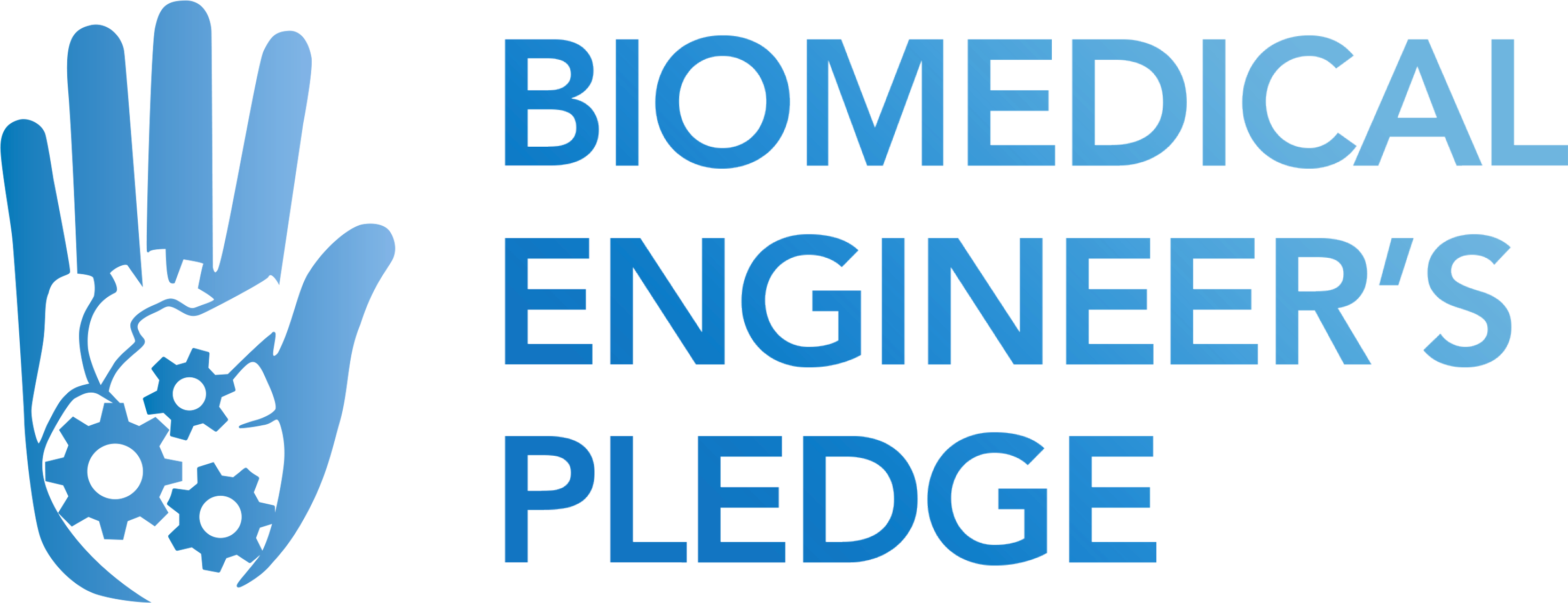About the Pledge
The professional practice of biomedical engineering can lead to severe consequences. These potential consequences do not differ from those expected in the exercise of the medical profession. Hence, the ethical framework of biomedical engineers (BMEs) should not differ substantially from the ethical framework of medical doctors (MDs).
In medicine, an element that is perceived as symbolic but essential in the formation of the ethical conscience of MDs is the "Hippocratic Oath", whose origin is uncertain but dates back to ancient Greece. The “Hippocratic Oath”, in its ancient versions, or in its contemporary adaptation by the World Medical Association, the "Physician's Pledge", also referred to as the Declaration of Geneva, is a brief not legally binding solemn declaration of ethical commitments that medical students take as a rite of passage in their final year or just after graduation. In other healthcare professions, such as nursing or pharmacy, sometimes the “Hippocratic Oath” is also taken. However, in its different versions, the “Hippocratic Oath” contains aspects that would not apply to the field of biomedical engineering.
The “Biomedical Engineer’s Pledge” has been conceived aiming at strengthening the ethical awareness of future biomedical engineers. It consists of a preamble sentence, ten promises, and a concluding sentence. Top priority is given to the first promise, which combines the fundamental principles of beneficence and non-maleficence.
In addition to strengthening the ethical awareness of biomedical engineering students, the adoption of the “Biomedical Engineer’s Pledge” could bring other beneficial results such as greater knowledge and appreciation, by society at large, towards biomedical engineering and greater collegiality between biomedical engineers and other healthcare professionals.
It is intended that commitment to the “Biomedical Engineer’s Pledge”, by reading it aloud, will be carried out in public events at universities. (If you intend to organize one of such events, please let us know.)
The “Biomedical Engineer’s Pledge” is the result of collaborative work by a diverse team.
The prerequisites for the “Biomedical Engineer’s Pledge” were initially defined by members of Universitat Pompeu Fabra (UPF), in consultation with members of the Bioethics and Law Observatory (OBD) of the University of Barcelona (UB), and members of the Applied Ethics Group of the Institute of Philosophy of the Spanish Research Council (CSIC). A drafting committee of three members (UPF and CSIC) was in charge of writing the first draft of the pledge.
It was decided to draft the pledge using as initial model, both formally and conceptually, the 2017 version of Declaration of Geneva, known as the “Physician’s Pledge”, of the World Medical Association (WMA) because of its widespread use.
The 2017 version of the “Physician’s Pledge” consists of a preamble sentence, 12 specific promises, and a concluding sentence. In total, in its English version, it has an extension of 208 words. For formal resemblance, it was decided that the “Biomedical Engineer’s Pledge” would follow the same structure. It was also decided that it would have a similar extension.
In addition, it was decided to avoid grandiloquent or archaic expressions to bring the language in the “Biomedical Engineer’s Pledge” close to the language used by young biomedical engineering students.
While some aspects in the “Physician’s Pledge” had to be disregarded because they would not apply to biomedical engineers, it was decided that some other aspects, not explicit in the “Physician’s Pledge”, had to be explicitly included in the “Biomedical Engineer’s Pledge”:
- Integrity and responsibility concepts.
- Avoidance of fraud against patients.
- Safeguarding of patient data.
- Minimization of animal experimentation.
- Protection of human participants in clinical trials.
- Environmental and economic sustainability.
- Universal health coverage.
After a few iterations, it was resolved that the number of specific promises could be limited to ten and it was decided to establish this feature as a requisite of the pledge. In this way, it is possible to refer in a strict etymological sense to the pledge as a “decalogue”. In addition, this establishes an association with the decimal numeral system, of historic importance in engineering.
Another substantial structural feature also emerged during the initial iterations: the pledge could be drafted as an initial, and of top priority, promise combining the fundamental principles of beneficence and non-maleficence followed by a general promise of integrity and responsibility followed by specific promises that can be understood as particularizations of what it means to act with integrity and responsibility.
After the first draft was concluded, invitations to participate in redrafting the pledge were sent to a diverse pool of present and past collaborators and graduate and undergraduate students. The team thus formed is diverse in multiple dimensions: gender (female (17), male(29)), nationality (15 countries, 4 continents), age (from 19 to 74 years), academic fields (engineering (28), medicine (6), veterinary (2), other biomedical fields (5), law (2) and philosophy (2)), professions (students, academics and researchers, regulatory experts and executives) and institutions (universities, research centers, large companies, and small companies).
The draft of the pledge and a description of the project were shared among the team members via a shared virtual folder. For one month the team members were able to voluntarily add comments to the draft and discuss these comments. After that, a revision committee of five members analyzed the comments and the discussions and produced a new draft of the pledge.
The new draft, together with a justification of the performed amendments, were again shared among the team members for a second round of comments and discussion. Then, the revision committee analyzed again the comments and the discussions and produced the final draft of the pledge in English, Spanish, and Catalan.
A manuscript about “Biomedical Engineer’s Pledge” can be found here: The Biomedical Engineer's Pledge 1.0 | Zenodo. This manuscript argues and explains the wording of the promises.
This work has been supported in part with funding from the European Union’s Horizon 2020 research and innovation programme (Project EXTEND—Bidirectional Hyper-Connected Neural System) under grant agreement No 779982.

